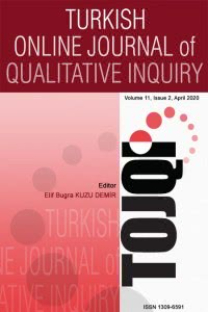Reflective Peer Feedback in the Practicum: Qualitative and Quantitative Practices
Öğretmenlik Uygulamasında Yansıtıcı Akran Dönütü: Nitel ve Nicel Uygulamalar
___
Azarnoosh, M. (2013). Peer assessment in an EFL context: Attitudes and friendship bias. Language Testing in Asia, 3(11), pp. 1-10.Boud, D., & Falchikov, N. (2006). Aligning assessment with long-term learning. Assessment and Evaluation in Higher Education, 31(4), pp. 399-413.
Brown, H.D. (2001). Teaching by principles: An interactive approach to language pedagogy. New York: Addison Wesley Longman, Inc.
Bryant, C.L., Maarouf, S., Burcham, J., & Greer, D. (2016). The examination of a teacher candidate assessment rubric: A confirmatory factor analysis. Teaching and Teacher Education, 57, 79-96. doi: 10.1016/j.tate.2016.03.012
Cheng, W., & Warren, M. (2005). Peer assessment of language proficiency, Language Testing, 22(3), pp. 93-121.
Cornu, R.L. (2005). Peer mentoring: Engaging pre-service teachers in mentoring one another. Mentoring and Tutoring, 13(3). pp. 355-366.
Creswell, J.W. (2005). Educational research: Planning, conducting, and evaluating quantitative and qualitative research. Upper Saddle River, NJ: Pearson.
Forbes, C.T. (2004). Peer mentoring in the development of beginning secondary science teachers: Three case studies. Mentoring and Tutoring, 12(2), pp. 219-239.
Göker, S.D. (2006). Impact of peer coaching on self-efficacy and instructional skills in TEFL teacher education. System, 34, 239-254.
Koç, B. & Ilya, A. (2016). Exploring pre-service language teachers’ perceptions and actual practices of giving feedback in micro-teaching. Procedia - Social and Behavioral Sciences 232. 421-429
Kollar, I., & Fischer, F., (2010). Peer assessment as collaborative learning: A cognitive perspective. Learning and Instruction 20(4), pp. 344-348.
Lindahl, K., Christison, M., & Tomas, Z. (2019). The impact of rubric use on peer feedback tasks in a TESOL program, Journal of Second Language Teaching & Research, 7(1), pp. 26-55.
Nguyen, H.T.M. (2017). Models of mentoring in language teacher education. Switzerland: Springer.
Nguyen, H.T.M, & Ngo, N.T.H. (2017). Learning to reflect through peer mentoring in a TESOL practicum, ELT Journal Volume 72(2), pp. 187-198.
Pennington, M.C., & Young, A.L. (1991). Procedures and instruments for faculty evaluation in ESL. In M.C. Pennington (Ed.), Building better English language programs:
Perspectives on evaluation in ESL (pp. 191-205). Washington, D.C.: NAFSA: Association of International Educators.
Ratminingsih, N.M., Artini, L.P., & Padmadewi, N.N. (2017). Incorporating Self and Peer Assessment in Reflective Teaching Practices. International Journal of Instruction, 10(4), pp.165-184.
Richards J.C., & Lockhart C. (2007). Reflective teaching in second language classrooms. New York: CUP.
Spiller, D. (2012). Assessment matters: Self-assessment and peer assessment. Retrieved September 30, 2019, from http://cei.ust.hk/files/public/assessment_matters_selfassessment_peer_assessment.pdf.
Sun, D.L., Harris, N., Walther, G., & Baiocchi, M. (2015). Peer assessment enhances student learning: The results of a matched randomized crossover experiment in a college statistics class. PLoS One, 10(12), e0143177. doi: https://doi.org/10.1371/journal.pone.0143177.
Vickerman, P. (2009). Student perspectives on formative peer assessment: an attempt to deepen learning? Assessment & Evaluation in Higher Education, 34(2), pp.221-230.
Yıldırım, A. & Şimşek, H. (2011). Nitel araştırma yöntemleri [Qualitative research methods]. Ankara: Seçkin Yayıncılık.
Yuksel, İ. (2011). The Effects of Post-observational Feedback Modes on Teaching Beliefs: Peer vs. Teacher-Mediated Feedback. Turkish Online Journal of Qualitative Inquiry, 2(1), 38-56.
Wenger, E. (1999). Communities of practice: Learning, meaning, and identity. Cambridge University Press.
White, E. (2009). Student perspectives of peer assessment for learning in a public speaking course. Asian EFL Journal – Professional Teaching Articles, 33(1), 1-36.
- ISSN: 1309-6591
- Yayın Aralığı: 4
- Başlangıç: 2010
- Yayıncı: Prof.Dr. Abdullah Kuzu
Öğretmenlik Uygulamasında Yansıtıcı Akran Dönütü: Nitel ve Nicel Uygulamalar
İlknur YÜKSEL, Banu Çiçek BAŞARAN
A Study on the Use of Suggestion Strategies among Turkish EFL Learners
Türkçeyi Yabancı Dil Olarak Öğrenenlerin Ders Dışında Kullandıkları Dil Öğrenme Ortam ve Deneyimleri
İlkokullarda Yetiştirme Programına (İYEP) İlişkin Öğretmen Görüşleri
Teachers Opinion about Support Program in Primary Schools (SPPS)
Reflective Peer Feedback in the Practicum: Qualitative and Quantitative Practices
